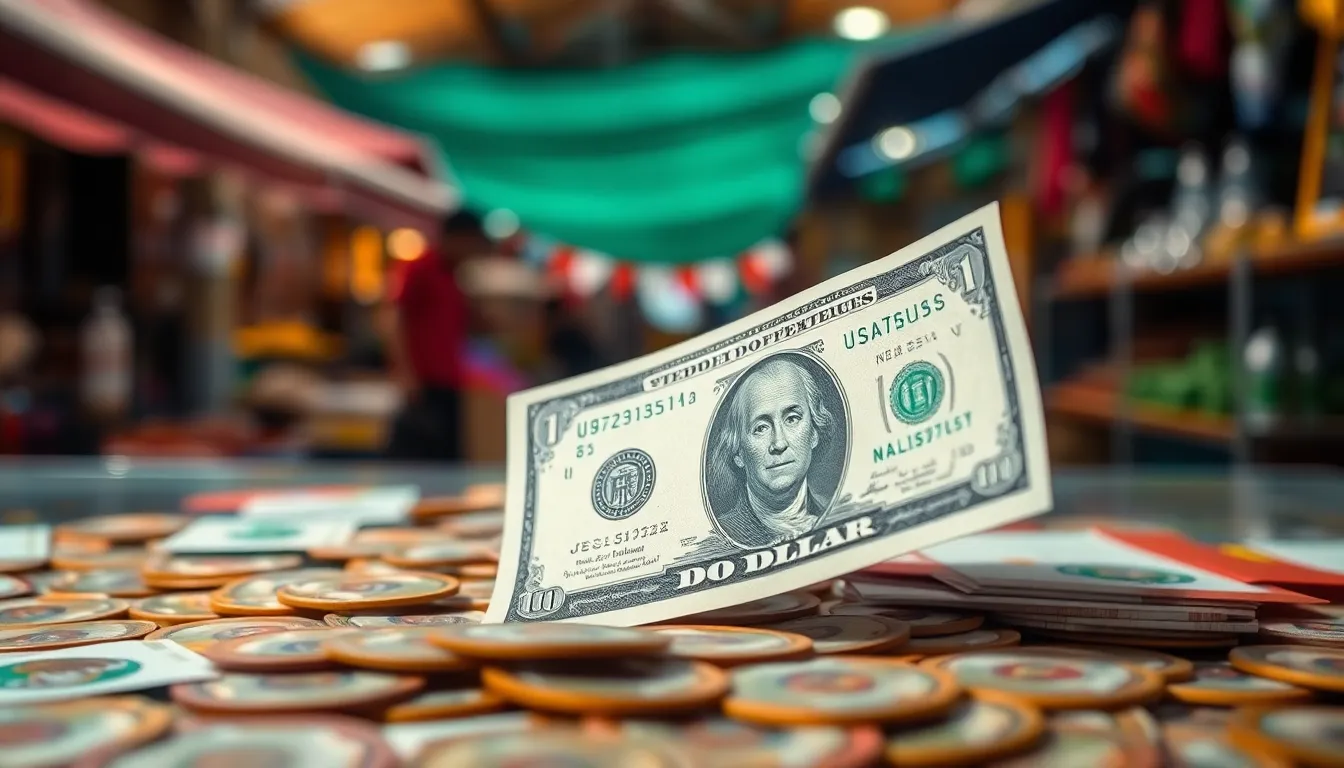The value of the dollar in Mexico plays a crucial role in the nation’s economy and affects countless aspects of daily life. As one of the most traded currencies globally, fluctuations in the dollar’s value can impact everything from inflation rates to purchasing power for both locals and tourists. Understanding these dynamics is essential for anyone looking to navigate the financial landscape in Mexico.
In recent years, the peso-dollar exchange rate has seen significant changes, influenced by various factors such as economic policies, global market trends, and geopolitical events. This article explores the current state of the dollar in Mexico, offering insights into its implications for consumers, businesses, and investors alike. Whether you’re planning a trip or considering investments, grasping the dollar’s value is key to making informed decisions.
Table of Contents
ToggleOverview of Valor Del Dolar En Mexico
The value of the dollar in Mexico plays a critical role in economic stability and growth. The exchange rate fluctuates regularly, influenced by multiple factors such as inflation rates, interest rates, and foreign investment trends. Current rates show a direct correlation between the peso’s strength and U.S. economic indicators.
Several key aspects impact the dollar’s value against the peso:
- Economic Policies: Monetary policies from the Bank of Mexico influence inflation and interest rates, which in turn affect the exchange rate.
- Global Market Trends: Changes in global commodities, trade agreements, and international relations can lead to significant shifts in currency valuation.
- Geopolitical Events: Political stability and government decisions within both Mexico and the United States create fluctuations in the dollar-peso exchange rate.
As of October 2023, the exchange rate stands at approximately 17.5 pesos per dollar, a figure reflecting both local economic conditions and broader global factors. Keeping track of these developments allows individuals and businesses to make informed financial decisions. Regular updates on the dollar’s value aid in anticipating costs for travel, importation of goods, and investment opportunities in Mexico’s diverse market landscape.
Historical Trends

The dollar’s value in Mexico has experienced significant shifts influenced by various economic factors. Analyzing these trends provides insight into the evolving relationship between the peso and the dollar.
Early Years and Economic Factors
In the early years, following Mexico’s economic upheaval post-Mexican Revolution, the peso stood relatively strong against the dollar. The fixed exchange rate system remained until the 1970s, anchoring the peso at about 12.50 per dollar. However, economic challenges, including inflation rates that soared to nearly 25% in the late 1970s, led to the gradual devaluation of the peso. The 1982 debt crisis prompted the government to adopt a flexible exchange rate, marking a shift in monetary policy that allowed the dollar’s value to fluctuate based on market conditions. By the end of the 1980s, the exchange rate had reached approximately 3,000 pesos per dollar.
Major Fluctuations Over Time
Major fluctuations have characterized the peso-dollar exchange rate since the 1980s. Notable events include the 1994 Tequila Crisis, which caused the peso to plummet, leading to an exchange rate near 7.0 pesos per dollar. Subsequent stabilization efforts allowed the dollar’s value to settle between 8 and 10 pesos through much of the late 1990s.
The 2008 financial crisis prompted another significant depreciation, with the exchange rate reaching about 14 pesos per dollar by early 2009. From 2010 to 2015, the peso appreciated slightly, fluctuating around 13.0 to 15.0 per dollar. Post-2016, geopolitical uncertainties and U.S. policy changes led to increased volatility, with the exchange rate nearing 20 pesos in 2019. As of October 2023, the exchange rate stands around 17.5 pesos per dollar, demonstrating ongoing impacts from global economic conditions and local policy decisions.
Current Exchange Rates
As of October 2023, the exchange rate stands at approximately 17.5 pesos per dollar, reflecting the complex interplay of various economic dynamics in Mexico. Understanding the factors influencing this rate is vital for consumers, businesses, and investors.
Factors Influencing Today’s Rates
- Inflation Levels: Inflation rates in Mexico directly affect the purchasing power of the peso against the dollar. Higher inflation typically leads to a weaker peso.
- Interest Rates: Decisions made by the Bank of Mexico regarding interest rates influence capital flows. Increased interest rates attract foreign investment, strengthening the peso.
- Foreign Investment: The level of foreign direct investment impacts the demand for pesos. Increased investment generally strengthens the local currency.
- Economic Policies: Government policies and economic reforms shape expectations about future economic conditions, influencing confidence in the peso.
- Global Market Trends: Fluctuations in global markets, such as oil prices and trade agreements, can alter the dollar-peso exchange rate by affecting Mexico’s trade balance.
Comparison with Other Currencies
| Currency | Exchange Rate (approx.) | Notes |
|---|---|---|
| Euro | 18.5 pesos | The euro has shown strength due to economic stability in the Eurozone. |
| British Pound | 21.2 pesos | The pound remains strong amid ongoing economic recovery efforts in the UK. |
| Canadian Dollar | 13.0 pesos | The Canadian dollar often parallels movements in commodity prices. |
| Japanese Yen | 0.12 pesos | The yen’s value is influenced by Japan’s monetary policy and economic growth. |
Understanding how the dollar compares to other currencies offers additional context for economic decisions and travel considerations in Mexico.
Economic Impact
The value of the dollar in Mexico holds significant economic implications. Fluctuations in the exchange rate influence various sectors, affecting everyday transactions and overall economic stability.
Effects on Import and Export
The dollar’s value directly influences Mexico’s import and export dynamics. A stronger dollar makes imports more expensive, leading to increased costs for businesses that rely on foreign goods. For instance, if the dollar strengthens against the peso, companies importing electronic devices or food products experience higher expenses, which can pass down to consumers. On the other hand, a weaker dollar can benefit Mexican exporters by making their products cheaper for foreign markets. As a result, sectors such as manufacturing and agriculture may see increased demand abroad when the peso’s value is relatively low against the dollar.
Impact on Consumer Prices
Consumer prices are significantly affected by the dollar’s exchange rate. When the dollar appreciates against the peso, imported goods become costlier, leading to higher prices for consumers. Products that heavily depend on foreign materials, like automobiles and electronics, often reflect these price increases. For example, a jump from 17.5 pesos to 19 pesos per dollar can raise the price of imported gadgets or apparel. Conversely, a weaker dollar may stabilize or even reduce prices for consumers, improving purchasing power. Understanding these relationships allows consumers to better gauge potential price changes and plan their purchases accordingly.
Future Predictions
Understanding future predictions about the dollar’s value in Mexico is essential for navigating economic landscapes. Expert analyses and market trends suggest potential shifts in the peso-dollar exchange rate.
Expert Opinions
Experts predict varying scenarios for the dollar’s value in Mexico. Some analysts foresee a stabilization around the current rate of approximately 17.5 pesos per dollar, citing consistent foreign investment and prudent monetary policies from the Bank of Mexico. Others warn of potential fluctuations due to global economic uncertainties and inflation pressures. For instance, should inflation rates rise significantly in the U.S. or Mexico, shifts in the exchange rate could occur. Analysts highlight the importance of monitoring interest rate decisions from the Federal Reserve, as these can sway the dollar’s strength.
Market Trends to Watch
Market trends provide insight into future exchange rate fluctuations. Investors should watch for changes in foreign investment levels, as capital inflow tends to strengthen the peso. Additionally, shifts in global oil prices can impact economic conditions, affecting the dollar’s value due to Mexico’s standing as a significant oil exporter. Observing U.S. economic indicators such as GDP growth and labor market statistics can also offer clues about future rate movements. Geopolitical events may introduce volatility in currency markets, making it crucial for individuals and businesses to stay informed on global developments.
The dollar’s value in Mexico plays a pivotal role in shaping the country’s economic landscape. Its fluctuations impact everything from inflation to purchasing power, affecting both locals and visitors alike. As the exchange rate hovers around 17.5 pesos per dollar, understanding its implications becomes essential for making informed financial decisions.
Monitoring the factors that influence the dollar’s strength is crucial for anticipating changes in costs related to travel and investment. With ongoing global economic shifts and local policy adjustments, staying informed can help individuals and businesses navigate the complexities of Mexico’s market. The dollar’s value not only reflects current economic conditions but also sets the stage for future growth and stability in the region.





